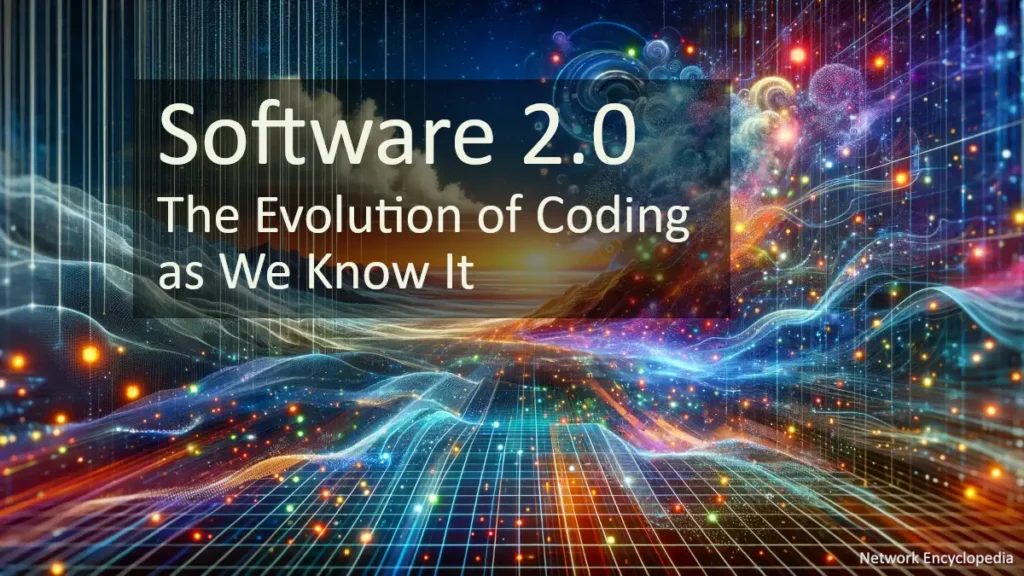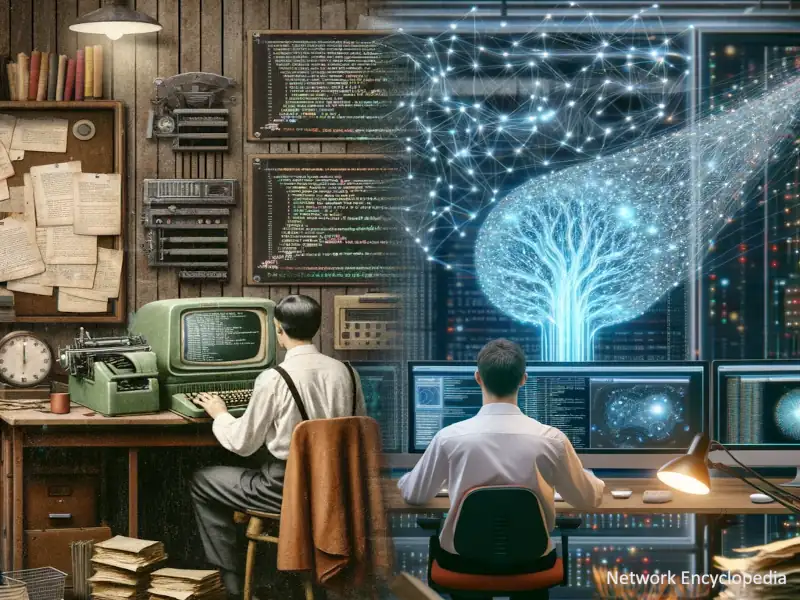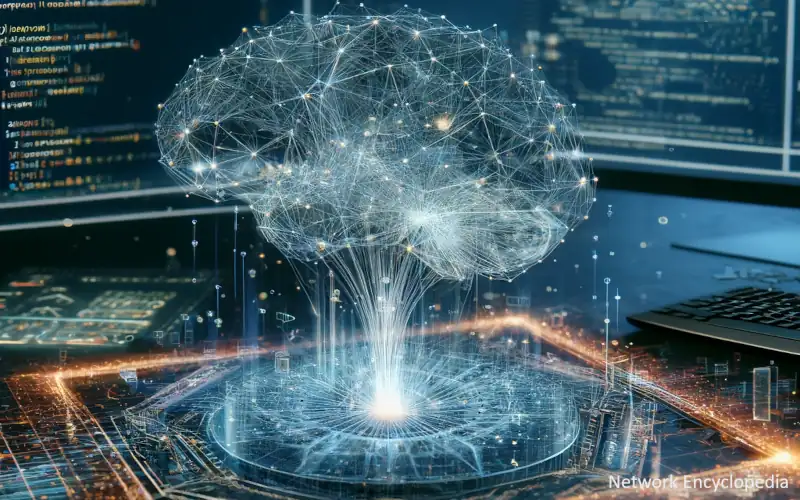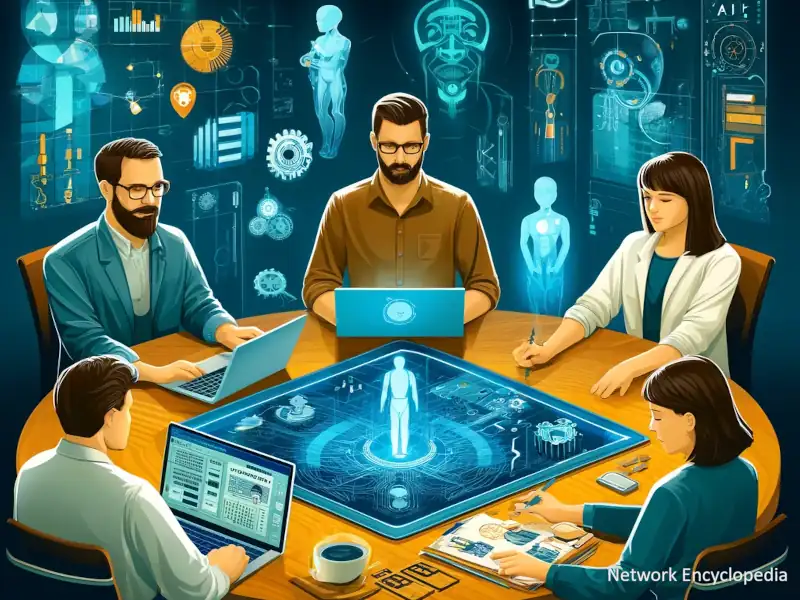Welcome to the era of Software 2.0, a term coined by Andrej Karpathy, a prominent computer scientist and former senior director of AI at Tesla. This concept represents a significant leap in the evolution of software development, where traditional programming takes a backseat to machine learning (ML) models. Software 2.0 isn’t about humans writing lines of code; it’s about creating systems that learn to solve complex classification and recognition problems on their own.
In this article, we’ll dive deep into the intricacies of Software 2.0, exploring how it’s reshaping the landscape of technology by automating the decision-making processes in software applications. This shift not only streamlines development but also enhances the capabilities of software to perform tasks that were once thought to require the meticulous touch of human hands. So buckle up and get ready to discover how Software 2.0 is transforming the way we think about, build, and interact with technology.

Table of Contents:
- What is Software 2.0?
- 1.1. The Shift from Software 1.0
- 1.2. Key Characteristics of Software 2.0
- 1.3. Examples in Current Technology
- The Building Blocks of Software 2.0
- 2.1. Neural Networks as Software Writers
- 2.2. Data: The New Code
- 2.3. The Role of Machine Learning Algorithms
- Implications of Software 2.0
- 3.1. Impact on Traditional Programming Jobs
- 3.2. New Skills and Roles in the Software 2.0 Era
- 3.3. Ethical Considerations
- Challenges and Limitations
- 4.1. Current Technological Limitations
- 4.2. Dependence on Data Quality and Availability
- 4.3. Debugging in Software 2.0
- The Future of Software 2.0
- 5.1. Predictions and Trends
- 5.2. Integrating Software 1.0 and 2.0
- 5.3. Final Thoughts and Conclusions
- References
1. What is Software 2.0?
Welcome aboard our little trip into the future! Picture this: traditional programming, or Software 1.0, is like crafting a meticulous recipe and expecting the kitchen (your computer) to whip up that dish flawlessly every single time. Now, enter Software 2.0. Instead of writing detailed recipes, we’re teaching the kitchen how to taste and tweak dishes until it learns to make the meal just right – no recipe card needed.
1.1. The Shift from Software 1.0
In the early days, we programmers wielded a mighty power: the ability to communicate directly with computers through code. It was clear, logical, and often unforgiving. Every instruction had to be precise, like giving directions to someone who can’t deviate from the GPS. But with the rise of AI and machine learning, we’re transitioning to a new phase. Now, we focus on designing systems that can learn and adapt from data. It’s less about micromanaging every step and more about guiding an intelligent system toward the desired outcome.

1.2. Key Characteristics of Software 2.0
Software 2.0 is defined by its ability to evolve. As these systems ingest more data, they improve. Think of it as a smart assistant that gets better at predicting what groceries you need the more you shop. These systems are dynamic, continually learning, and incredibly data-driven, distinguishing them sharply from their static, pre-programmed predecessors.
1.3. Examples in Current Technology
You’re probably using Software 2.0 right now without even knowing it! From recommendation engines on Netflix and YouTube to voice assistants like Siri and Alexa, these are all applications where Software 2.0 shines. They analyze heaps of data to learn and provide responses that are increasingly accurate and personalized.
As we delve deeper into the nuances of Software 2.0, keep your seatbelts fastened. This ride gets more exciting with every byte of data!
2. The Building Blocks of Software 2.0
2.1. Neural Networks as Software Writers
Imagine if Shakespeare were a programmer. Instead of penning plays, he’d be designing neural networks—modern literature’s new scribes. In the realm of Software 2.0, neural networks are the star writers, tasked with creating software that can adapt, learn, and optimize itself. Unlike traditional programming where the logic must be meticulously spelled out by human developers, neural networks learn to generate and refine their own algorithms through training. This is akin to training a novice chef through trial and error until they perfect their recipes without your help. They iterate over massive datasets, learning from each example, much like a baby learns to speak by listening to adults.

2.2. Data: The New Code
If neural networks are the writers, then data is their ink. In Software 2.0, the conventional code that meticulously details every step is replaced by data. This shift means the focus is less on instructing the computer on every tiny step and more on providing it with high-quality data from which it can learn. The better the quality of data, the more efficient and effective the neural network. This transformation is akin to moving from manual car manufacturing to an automated, sensor-laden production line where the machine adjusts in real time to changes in design or material flaws.
2.3. The Role of Machine Learning Algorithms
Machine learning algorithms are the editors of Software 2.0. They refine the ‘drafts’ written by neural networks, ensuring that the end software is not just functional but also optimal. These algorithms tweak and tune models based on performance metrics, much like an editor polishes a manuscript to enhance its readability and impact. Their job is crucial because they ensure that the AI doesn’t just learn, but learns well, effectively making sure that our AI systems don’t just mimic the average but strive for the top.
3. Implications of Software 2.0
3.1. Impact on Traditional Programming Jobs
As the shift towards Software 2.0 gains momentum, the landscape of traditional programming jobs is evolving. Think of it as the transition from typewriter to word processor. Initially, it may seem like jobs are disappearing—traditional roles that involve routine coding might decrease. However, like the rise of word processors, new technology also creates new opportunities and demands new skills. Programmers might move away from writing explicit lines of code to focusing on tuning algorithms and managing data flows. The role isn’t diminishing; it’s evolving, requiring a blend of coding knowledge and data science skills.
3.2. New Skills and Roles in the Software 2.0 Era
With the introduction of Software 2.0, we’re not just seeing a shift in skills but a whole new world of opportunities. Future tech professionals might need to be as fluent in machine learning techniques as they are in traditional programming languages. Roles like Machine Learning Engineer, Data Scientist, and AI Specialist are becoming more common. Moreover, there’s a growing need for ‘AI translators’—experts who can bridge the gap between technical AI solutions and practical business applications. It’s like being a tour guide in a foreign country; not only do you need to know the landscape, but you also need to help others navigate it effectively.

3.3. Ethical Considerations
As we delegate more decision-making to machines, ethical considerations skyrocket. Software 2.0 technologies can sometimes feel like a Pandora’s box—unleashing capabilities that, if unchecked, could lead to unintended consequences. Issues like bias in AI, surveillance concerns, and the potential for job displacement are the elephants in the room that need to be addressed. Ensuring that these intelligent systems are not just efficient but also fair and transparent is crucial. Like Spider-Man’s Uncle Ben said, “With great power comes great responsibility.” The creators and operators of Software 2.0 systems carry a hefty burden to ensure their use benefits society positively.
As we continue to explore the vast landscapes of Software 2.0, remember that this journey isn’t just about technological change—it’s about adaptation. How we adapt to these changes, leverage them for better outcomes, and address the accompanying challenges will define the next generation of software development. Stay tuned, keep learning, and remember, the future is as bright as we program it to be!
» Read also: Ethics in Machine Learning.
4. Challenges and Limitations
4.1. Current Technological Limitations
Even the brightest stars have dark spots, and Software 2.0 is no exception. Currently, the complexity and computational requirements of training large-scale neural networks can be staggering. Not every entity can harness the power of massive datasets and the computational horsepower needed to process them. This is somewhat like trying to stream a 4K movie on a dial-up connection—there’s ambition, but the infrastructure may lag behind. Furthermore, issues such as algorithmic transparency and the interpretability of machine learning models remain significant hurdles. How do you trust a decision if you can’t understand how it was made?
4.2. Dependence on Data Quality and Availability
The adage “garbage in, garbage out” has never been more pertinent. In Software 2.0, the quality of the output is directly dependent on the quality of the input data. This creates a critical dependency on having access to large, well-curated datasets. In areas where data is sparse or biased, the systems can perform poorly, or worse, propagate existing biases. This challenge calls for robust data governance and ethical data collection practices to ensure that our AI systems are both fair and effective.
4.3. Debugging in Software 2.0
Debugging in Software 2.0 is more like detective work than traditional bug fixing. Since the system learns from the data it’s fed, pinpointing why it makes a certain decision can be as tricky as understanding why a cat decides to sit in a box. Traditional debugging tools and techniques, which rely on stepping through code or checking state conditions, are often inadequate for systems where decisions are made by inscrutable machine learning models. This necessitates a new set of tools and approaches to ensure reliability and correctness in AI-driven applications.
5. The Future of Software 2.0
5.1. Predictions and Trends
The trajectory of Software 2.0 is pointing towards more autonomy, more efficiency, and deeper integration into our daily lives. We can expect to see AI systems that not only manage data but also create and refine their own algorithms to solve complex problems across industries, from healthcare to transportation. The trend is towards systems that are increasingly capable of unsupervised learning, where they require less human intervention to make accurate predictions and decisions.
5.2. Integrating Software 1.0 and 2.0
Integration is the name of the game as we move forward. The future will likely not be dominated by Software 2.0 alone but will see a symbiotic existence with Software 1.0. There are scenarios where precise, rule-based programming is necessary and others where adaptive, data-driven decision-making is superior. For instance, safety-critical applications such as in aviation or nuclear power generation may still rely heavily on Software 1.0 for predictable, controlled outcomes, while using Software 2.0 to optimize operations and maintenance.
5.3. Final Thoughts and Conclusions
The dawn of Software 2.0 doesn’t spell the end of Software 1.0, but rather heralds a new era of collaboration between human programmers and intelligent systems. It promises a future where the heavy lifting of data processing can be offloaded to algorithms, allowing developers to focus on strategy and innovation. As we steer this ship, it’s crucial to navigate carefully, ensuring ethical practices, transparency, and inclusiveness in the burgeoning landscape of AI technologies.
6. References
- “Deep Learning“, by Goodfellow, Ian, Yoshua Bengio, and Aaron Courville. MIT Press, 2016.
- “Machine Learning“, by Mitchell, Tom M. McGraw-Hill, 1997.
- “Reinforcement Learning: An Introduction“, by Sutton, Richard S., and Andrew G. Barto. MIT Press, 2018. [ISBN: 9780262039246]
- “What is Software 2.0, Why has Tesla Pioneered it, and How will it change your world?”, by ARTIMATIC, Oct 2022.
- “The road to Software 2.0”, by Myke Loukides and Bn Lorica, O’Reilly, Dec 2019.